This is, actually, the third time I’ve approached this subject, and it will be another variation apart from the first time, and the second. The subject is the old “But what if you’re wrong?” challenge that the religious dearly love to use against atheists, never realizing this is not even a fraction as destructive as they imagine it. Pascal’s Wager is a variation of this challenge, an extremely simplified one that allows the faithful to reach the answer that they like, because an honest examination of probability, with all the variables therein, doesn’t produce an encouraging answer. What if god was really serious about the humility thing, and considers even passing grades in school as too much ego? Or maybe it’s the pursuit of wealth bit. What if it really is ba’al all along?
But as much fun as that can be, I’m aiming a little higher than that, and even going to consider (just for the sake of argument) the lame “what if?” scenario. Let’s take a moment and realize that the question is really, “What if everything that I believe is correct, and you’re wrong?” – because it’s abundantly clear that nobody posing this question is actually considering how many different ways anyone could be wrong, especially themselves, nor any other religion but their own, nor any facet therein that they don’t follow very faithfully, like trimming facial hair or avoiding shellfish. And they never appear to consider what it is that we do to avoid being wrong, like examining evidence and testing hypotheses and all that jazz. I addressed that the first time around.
But let’s say that any god you care to name really exists, and is now facing me, the unapologetic unbeliever. The imagined response is either that I’ll crash to the ground and beg forgiveness, or be defiant and continue not to believe or something, whereupon I’ll be cast into hell to the great delight of far too many religious folk, those who really do have a sadistic streak. Either way, ha ha, the religious person can feel all warm and cuddly inside I guess.
Still, there are a few things to consider here. First off, a god standing in front of me is exactly the kind of evidence that I require to be convinced. Because, let’s face it, religious folk have offered (for centuries) nothing but word games and wishy-washy interpretations, mostly in their own defense. And for the sake of continuing this line, I’m going to ignore the inherent skepticism I would have over this sudden manifestation, all the possibilities of misinterpretation, hallucination, and hoaxing that I’d consider (just like any other truly incredible event,) and assume we’ve established this god pretty convincingly… somehow. Now what?
The first thing that comes to mind is how often every god I’ve ever heard of is a petulant, emotional, often tyrannical being – I honestly couldn’t believe that there would be any likely way to appease this entity. Total crap shoot. While any believer might have a firm idea of what their god really is (or at least claims to,) I’ve personally never seen a dependable trend from any account given anywhere, and so could trust no particular approach nor determine any likely expectation. I’m not being frivolous. Take the abrahamic god, who wiped out every last species on the planet in a worldwide flood, for… what reason, exactly? Wasn’t this its own creation? Wasn’t it supposed to know everything that could happen? What about the bhagavad gita and its numerous interpretations over whether violence is condemned or condoned – shouldn’t a god be able to make this important message perfectly clear? Not one scriptural or oral account that I’ve come across is free from such displays of petty behavior or gross inconsistencies; there is a radical difference between reading scripture in search of supportive quotes for a pre-existing mindset, and reading it to actually obtain guidance or useful, perhaps even transcendent, information. Those who have pursued the latter have usually not been very enlightened.
But okay, so let’s assume, somehow, that the whole petty wrath, schizo thing is unlikely to happen – god is seeming pretty cool about it all and nominally coherent. So what answer do I have regarding why I lack faith?
Well, faith is actually a pretty stupid thing to have, from all of our experience. Faith in our fellow human beings is shattered so frequently that only an abject moron would continue to extend it – we rely on past experience, and covering our asses, and having some recourse if our expectations are somehow not met. We have contracts, and health inspectors, and banks that guarantee the presence of money, and we watch what other drivers do carefully, because faith is a ridiculous concept that has repeatedly proven its total lack of value.
I’ve pointed out before, even the religious look for something other than faith, constantly. We have everything from religious artifacts to expeditions into holy lands, creative interpretations of scripture to the frantic quest for things that can be called miracles – these are not aspects of faith, but the desperate search for evidence. That’s what human beings look for – we want the proof.
In this situation, there are two possibilities for why this should be. The first is that it is an evolved trait of an evolved species, and it’s not really hard to see how such a thing could come about from natural selection; individuals that ensure themselves of certain information (such as whether a tree is benign or dangerous) by observation and past experience can obviously fare much better than those who believe in some property for no reason.
The second possibility is that, as intended beings of some god, we were designed to be this way. I would like to think that I shouldn’t have to point out the contradiction in here, but I often do: a god that expects/demands faith but makes its creation rely on proof is not exactly working with an efficient model. Even if this being had some pat explanation as to why this should be, it doesn’t change anything until it’s been communicated to us – barring that, of course, I’m going to stick with what works best, which is requiring some kind of proof for extraordinary claims. You see, even without any built-in desire for evidence, it remains a useful process.
It also should be abundantly easy for some hyperpotent being to make itself known, obviating any need for faith in the first place. Throughout every culture, throughout history, every god has taken pains (if we are to believe the folklore) to remain hidden; this has progressed to the point of most folk declaring that their god exists in a realm not detectable or even fathomable by any form of physics, while theologians blather about abstract forms of existence such as a “ground of being” (I’m not making this up.) UFO enthusiasts, by the way, explain their utter lack of substantial, unquestionable evidence by claiming that the government is suppressing it all; they’ve learned something from religion. Because neither is an explanation – they’re excuses to avoid producing any positive evidence in the first place, the exact details that would differentiate a god (or extra-terrestrial visitations) from mere imagination. When illustrating a point, Carl Sagan used the invisible dragon in his garage; I’ll just tell you about the utcru, a peculiar extra-dimensional critter I just made up by slapping my fingers on the keyboard (it originally had a 6 and a Y in there, but it’s easier to pronounce this way.) I can tell you all the properties that it has that you can never detect, but none of these make it even remotely possible to exist – what we need for that is something positive and unmistakeable, the same kind of stuff that’s missing for any and all gods.
It’s missing, by the way, throughout every realm of our examination, from the sub-atomic level all the way out to millions of light years away among the stars. Physics works amazingly well with just a few simple laws, and this shows everywhere – we could never have achieved the advances that we have without them. The very fact that you’re reading these words means that every facet, from my pressing on plastic buttons on my keyboard through their interpretation by my computer, subsequent transmission by wire and storage into a database, then retrieval from the database because of the request from your computer or toy phone or whatever and the eventual display on your screen, means that all of it went without a glicth – we’re going well beyond dependable here.
Which brings us to two distinct possibilities. The first is that whatever proposed god(s) wanted it this way, desired to hide away and not take an active part in 99.9999999999999999999% of what occurs (at least – I’m being conservative.) Therefore, who am I to deny this, and what kind of blame should I accept for doing so? My answer is, “None at all” – if you, or anything else, has a problem with that, tough shit. A non-intervening god and no god at all are indistinguishable states. But the second possibility is that some extreme being laid the ground rules of physics and let it all play out through these functions, knowing how it would eventually go. That means, of course, that I could be no other way, and also means predestination and no free will and all that jazz. Worse, the non-intervening god of both of these options possesses none of the properties that religious folk want to believe in – it possesses no properties at all (just like the non-existent god and the utcru,) until and unless it decides to establish some solid evidence of its existence.
Sure, there still remains the half-ass possibility that some god still exists someplace, despite being completely illogical and rather inept at planning, that would still be mad at me for not believing; this could be a bad thing for me. But the same could be said for anyone I meet on the street being psychotic enough to kill me over some illogical concept; it is, in fact, infinitely more probable because we actually have examples of people like that (this is how probability works – without examples or known factors that could support a god, the probability of a god is zilch, sorry to say.) Despite the dire numbers seemingly implied in that statement, I’m still not going to walk around in fear of meeting this psychotic person, since it remains exceedingly rare and there’s nothing I could do about it anyway. And I sure as fuck wouldn’t worship anyone like that.
And that itself hints at another, more philosophical aspect. To many, I believe, there’s an underlying recognition that any such god will know exactly what’s going on in my mind – presumably, this should be worrisome. But what’s the alternative, then? Believing in gods through fear, or consequence? What about through insecurity, or ego over a perceived superiority? Are these any different, any more likely to convince this god that I am worthy? For some reason, a very large number of people seem to think that gods would be petty enough to be concerned about who’s kissing their ethereal asses, rather than what kind of improvements and beneficial acts mortals can perform in their brief existence that, so we’re often told, serves only as a (very) final exam.
I have been reminded quite often that we can’t possibly know the mind of god, and believe it or not, I’m totally on board with that – any kind of extra-dimensional intelligence is unlikely to have thought processes anything remotely like our own. This logically means that not one religious person knows either – not whether their god is beneficent, not whether they have the right one, not how their god feels about abortion or the proper way of preparing sausage or how they should react to infidels. Obviously, not very many of the devout actually believe this aspect, or have even bothered to stop and figure out what it actually means, which is one of the reasons why I don’t find much value in their arguments.
But what we can be sure about is our lives, right here, right now, and most especially, what kind of attitude is useful to our fellow humans. While religious folk may continue to argue some vapid point up there or another, not because they’ve established a high likelihood of their god, but because they get some emotional satisfaction, some validation, out of the entire idea, I’m going to argue that what we have incontrovertible evidence of is far more worthy of our attentions, our goals, and our emotional perspective. We have, perhaps unique among all species on this planet, the ability to think rationally, to weigh probabilities, to extrapolate effect and benefit and improvement. It seems a ridiculous shame to waste this on cultural artifacts that never made sense and have no supporting evidence.
*Yes, ‘glitch’ being misspelled was intentional – I do have a spellcheck on this machine, as well as a sense of humor.




















































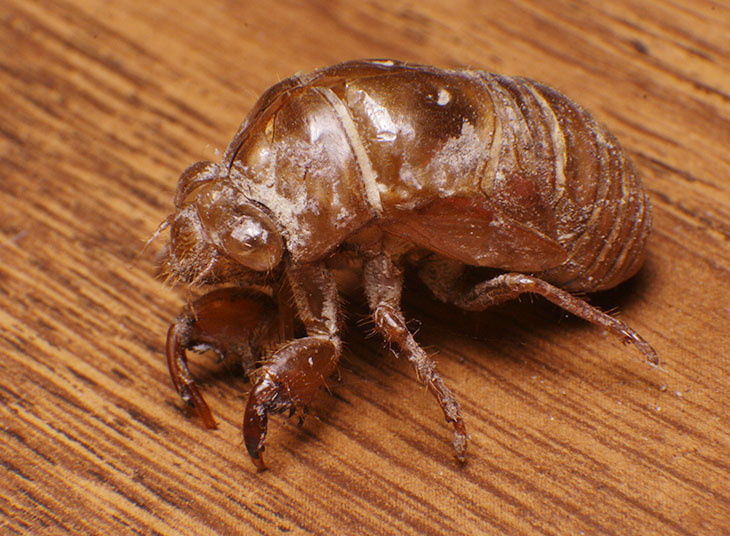
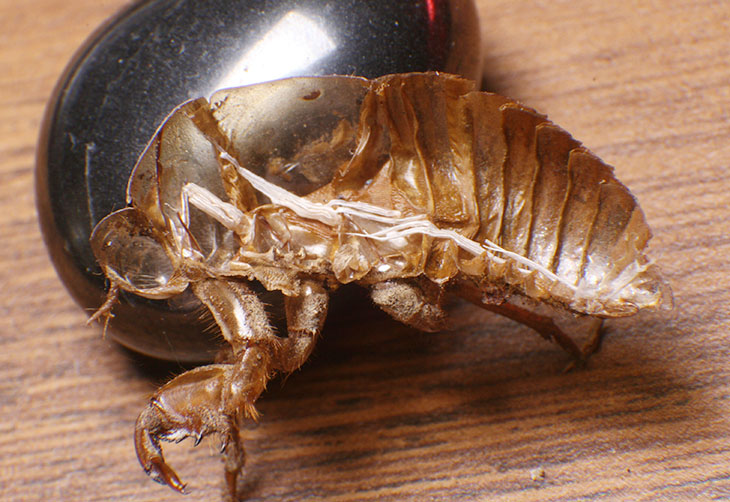
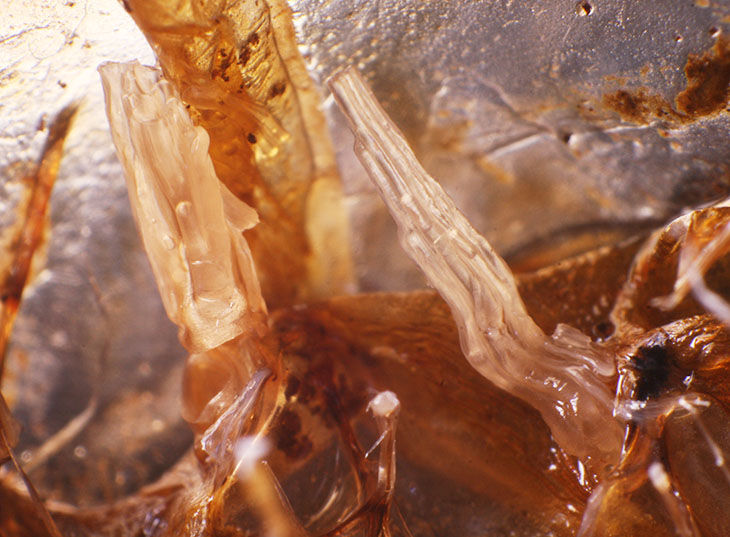
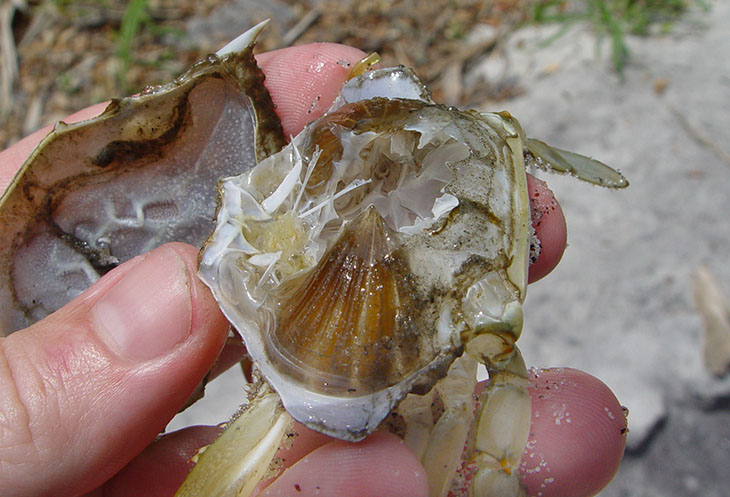
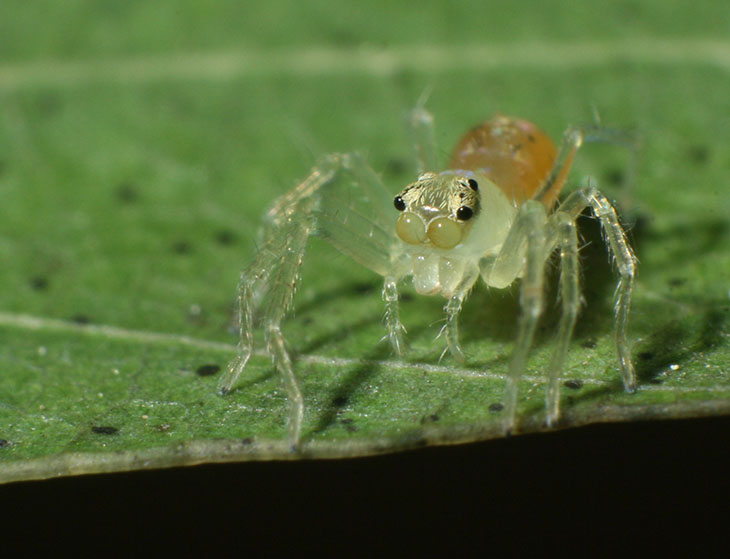
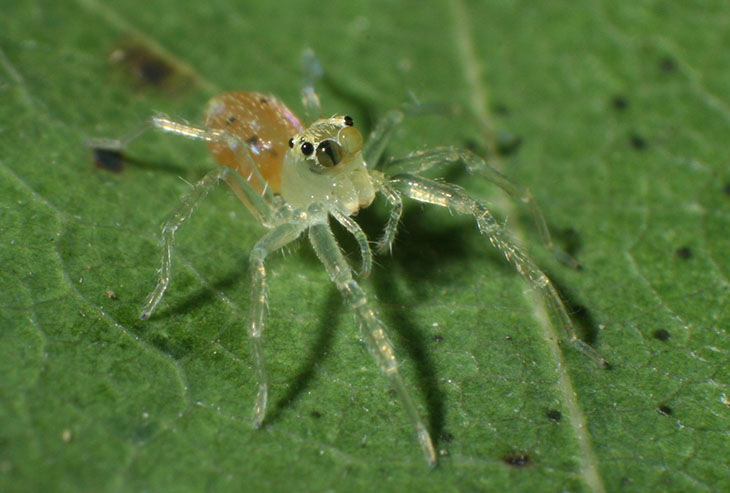
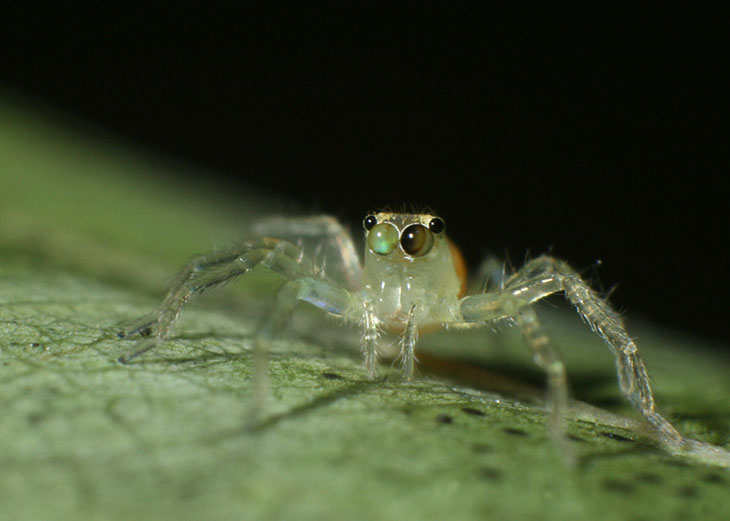
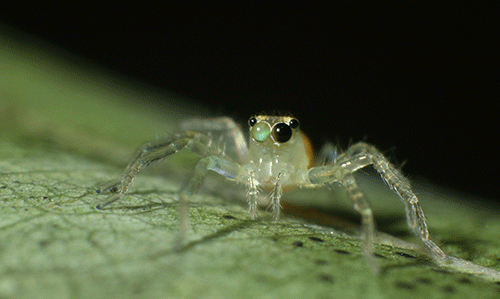 While I wanted a little more eye motion than I managed to capture, I still couldn’t resist making an animated gif from a rapid sequence that I’d fired off – the actual frames I got were spaced slightly farther apart in timing than what appears here, but not significantly. The slight change in perspective is strictly my own movement; I’m lucky to have kept focus while doing so. And yes, I’ve talked about the
While I wanted a little more eye motion than I managed to capture, I still couldn’t resist making an animated gif from a rapid sequence that I’d fired off – the actual frames I got were spaced slightly farther apart in timing than what appears here, but not significantly. The slight change in perspective is strictly my own movement; I’m lucky to have kept focus while doing so. And yes, I’ve talked about the 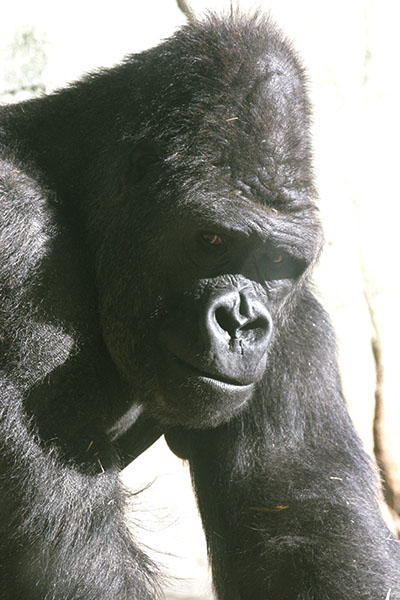

 I, meanwhile, went in the opposite direction yesterday. On what I’m pretty sure is a pokeweed plant (Phytolacca americana, the subject of the dried berry images
I, meanwhile, went in the opposite direction yesterday. On what I’m pretty sure is a pokeweed plant (Phytolacca americana, the subject of the dried berry images 
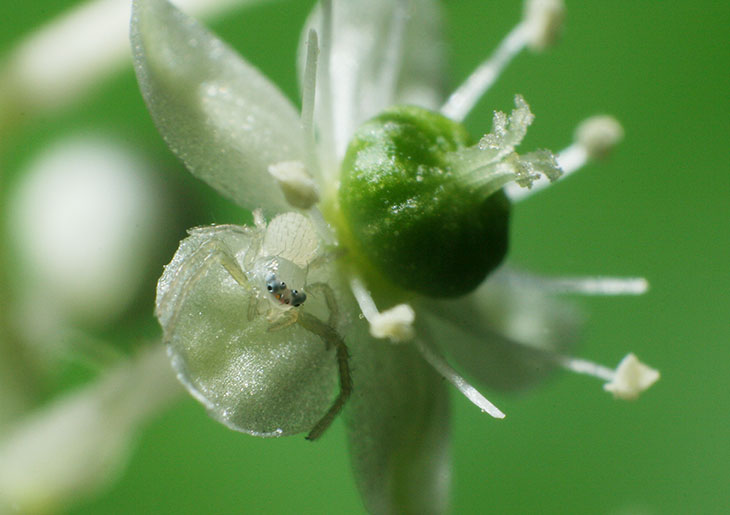
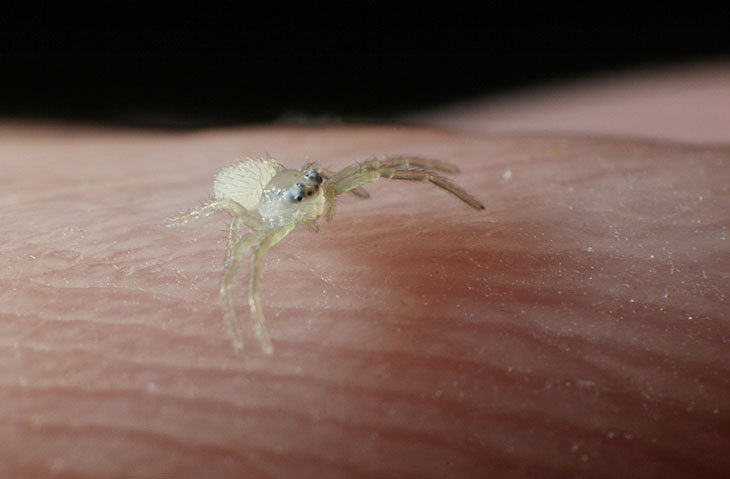
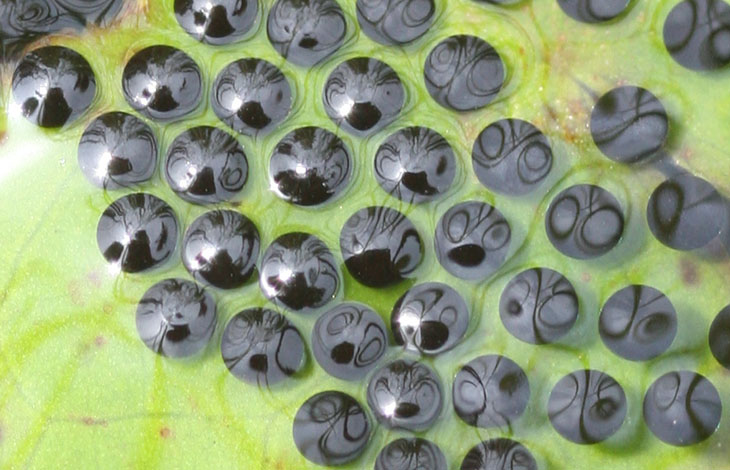
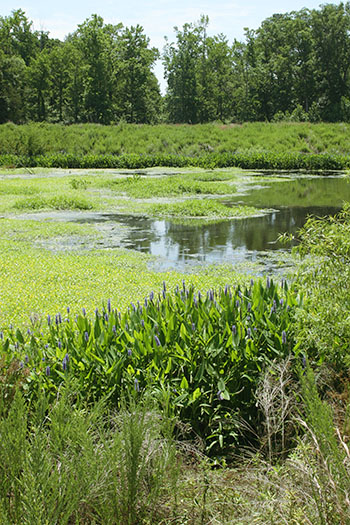 I mentioned in the previous post that I went someplace that I was going to feature here shortly; this is not the time. Since then, I did a short side trip and got a bunch of shots that I’m bumping ahead of those, because I want to, so there.
I mentioned in the previous post that I went someplace that I was going to feature here shortly; this is not the time. Since then, I did a short side trip and got a bunch of shots that I’m bumping ahead of those, because I want to, so there. None of them were calling, and there was practically no activity until they deemed I was too close, but they were pretty easy to spot, and I saw dozens. Most were quite small, about half adult size or smaller, and a few sported the last vestiges of their tadpole tails, obviously this spring’s brood. While adults can get up to 5 or 6 centimeters, the average size is about 3, and the ones I was seeing typically ran 1 to 2 cm in body length. The longitudinal white stripe is a distinctive identifier, but in the right light, they gain a faint iridescence and a hint of gold in the white. As treefrogs, they have excellent adhesion to just about any surface and prefer to be vertical, usually selecting something as close to their body color as possible to perch upon – this means, when you’re out looking for them, you aim for the plants with the brightest green, preferably big leaves in or around water – pickerelweed (Pontederia) is thus ideal.
None of them were calling, and there was practically no activity until they deemed I was too close, but they were pretty easy to spot, and I saw dozens. Most were quite small, about half adult size or smaller, and a few sported the last vestiges of their tadpole tails, obviously this spring’s brood. While adults can get up to 5 or 6 centimeters, the average size is about 3, and the ones I was seeing typically ran 1 to 2 cm in body length. The longitudinal white stripe is a distinctive identifier, but in the right light, they gain a faint iridescence and a hint of gold in the white. As treefrogs, they have excellent adhesion to just about any surface and prefer to be vertical, usually selecting something as close to their body color as possible to perch upon – this means, when you’re out looking for them, you aim for the plants with the brightest green, preferably big leaves in or around water – pickerelweed (Pontederia) is thus ideal.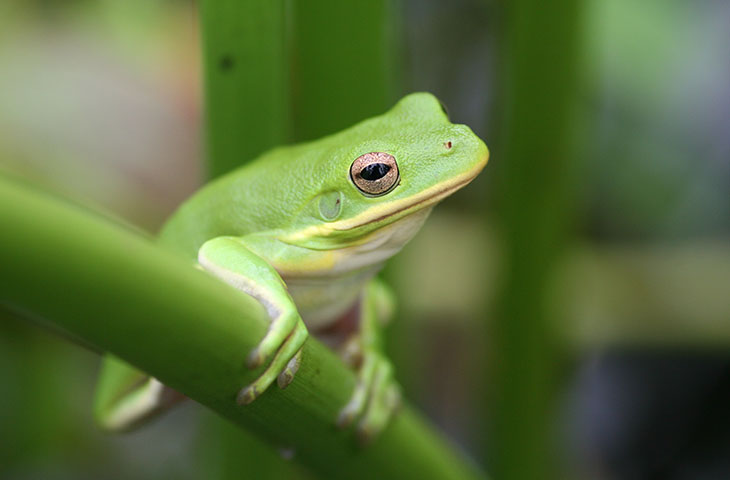
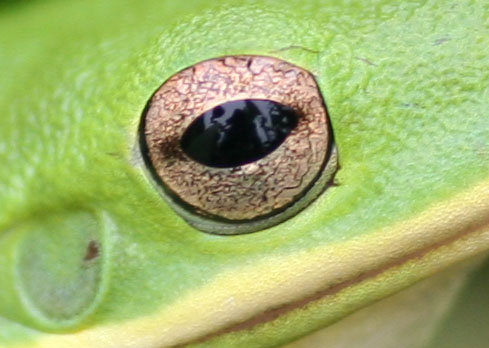 Now I’m going to pause here for a bit of interesting trivia before moving on. This is the same image cropped down to see the eye detail. You can’t quite make out the camera and I, due to the light being at my back as I aimed downwards, but you can see the flash on the bracket arm to the left, as well as plenty of other leaves surrounding me. These were typical conditions, and even leaning close for many of these shots meant I was disturbing stems and leaves which could send warning signals to the frogs. Progress was glacially slow, but that was okay, since I was surrounded by subjects.
Now I’m going to pause here for a bit of interesting trivia before moving on. This is the same image cropped down to see the eye detail. You can’t quite make out the camera and I, due to the light being at my back as I aimed downwards, but you can see the flash on the bracket arm to the left, as well as plenty of other leaves surrounding me. These were typical conditions, and even leaning close for many of these shots meant I was disturbing stems and leaves which could send warning signals to the frogs. Progress was glacially slow, but that was okay, since I was surrounded by subjects.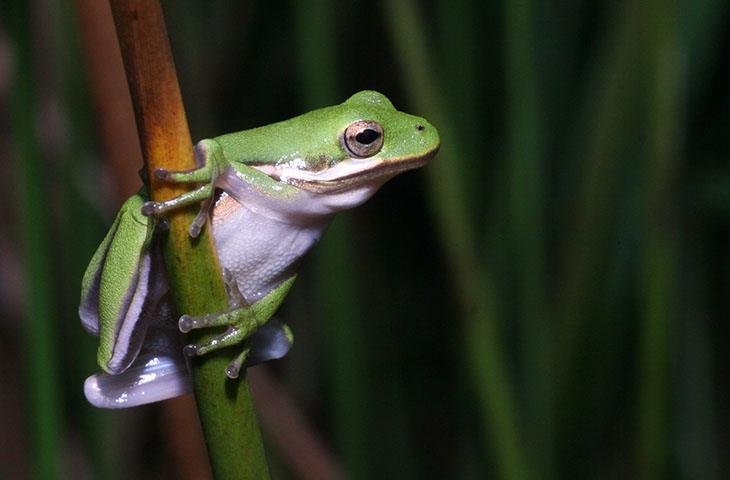
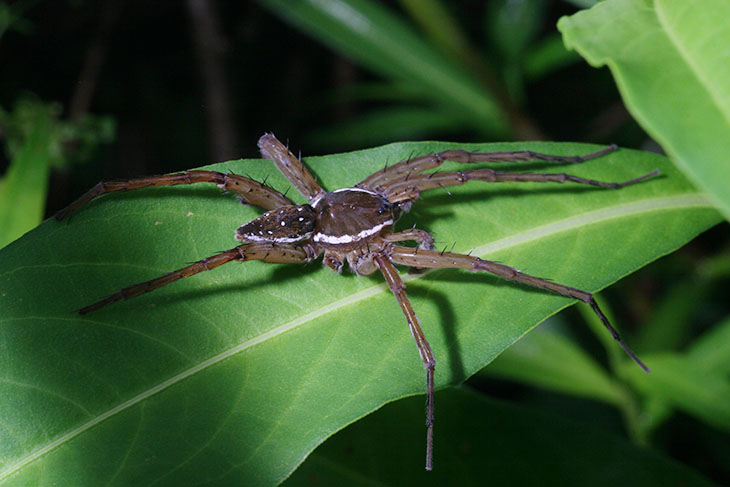
 Naturally, the treefrogs weren’t the only subject I chased while down there, and if you think I can go three days without photographing a spider, you haven’t read very far into this blog. The six-spotted fishing spider (Dolomedes triton) above wasn’t quite big enough to spread across my palm, but close. He’d seen me coming and sought refuge under the leaf, but I poked a finger underneath and flushed him back on top again. This might seem like I was inviting a bite, but I’ll say it again: spiders are shy, and typically avoid any kind of contact. The Eastern pondhawk (Erythemis simplicicollis) at right, meanwhile, not only didn’t care much about my presence, it almost seemed to follow me around – likely, I was seeing multiple dragonflies instead of the same one. I also shot a few tiny little damselflies and a remarkably colorful grasshopper of some sort, which I may feature a little later on.
Naturally, the treefrogs weren’t the only subject I chased while down there, and if you think I can go three days without photographing a spider, you haven’t read very far into this blog. The six-spotted fishing spider (Dolomedes triton) above wasn’t quite big enough to spread across my palm, but close. He’d seen me coming and sought refuge under the leaf, but I poked a finger underneath and flushed him back on top again. This might seem like I was inviting a bite, but I’ll say it again: spiders are shy, and typically avoid any kind of contact. The Eastern pondhawk (Erythemis simplicicollis) at right, meanwhile, not only didn’t care much about my presence, it almost seemed to follow me around – likely, I was seeing multiple dragonflies instead of the same one. I also shot a few tiny little damselflies and a remarkably colorful grasshopper of some sort, which I may feature a little later on.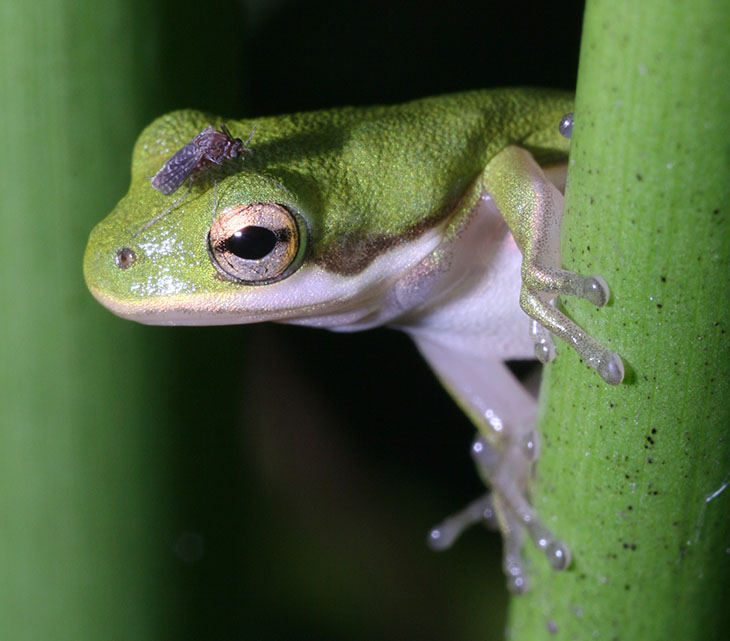
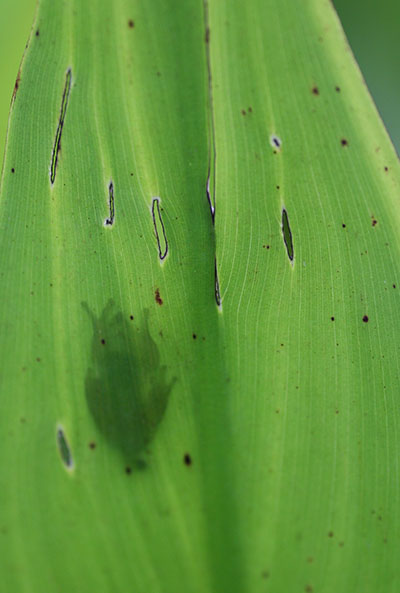 Had the sun peeked out suddenly, I might have been able to spot more examples like this, but it would have chased all of the frogs under cover quickly, so my window of opportunity would have been brief. Maybe I can capture some more examples of this right at sunrise some day – the last time I tried to catch sunrise at this pond, the day broke overcast for the first time in weeks – this was during the drought before the latest patch of downpours came along.
Had the sun peeked out suddenly, I might have been able to spot more examples like this, but it would have chased all of the frogs under cover quickly, so my window of opportunity would have been brief. Maybe I can capture some more examples of this right at sunrise some day – the last time I tried to catch sunrise at this pond, the day broke overcast for the first time in weeks – this was during the drought before the latest patch of downpours came along.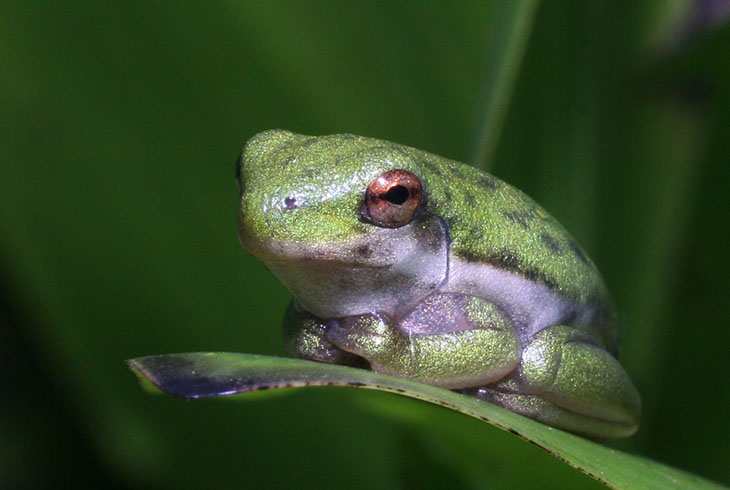
 First off, I’m going to mention my long absence and the faintly amusing bit about it. I was traveling, one of the few chances I’ve gotten recently, which would be enough to explain the period without posts – except that, I’d prepared a bunch ahead of time and scheduled them to appear while I was away. The dry period occurred after I came back, when I wasn’t motivated by any topic to get something new up. The trip didn’t involve much postable stuff either, and you’re looking at the sum total of images I took that fit into my typical stock (well, that’s not true, since I have several variations of this, but nothing of other subjects.)
First off, I’m going to mention my long absence and the faintly amusing bit about it. I was traveling, one of the few chances I’ve gotten recently, which would be enough to explain the period without posts – except that, I’d prepared a bunch ahead of time and scheduled them to appear while I was away. The dry period occurred after I came back, when I wasn’t motivated by any topic to get something new up. The trip didn’t involve much postable stuff either, and you’re looking at the sum total of images I took that fit into my typical stock (well, that’s not true, since I have several variations of this, but nothing of other subjects.)